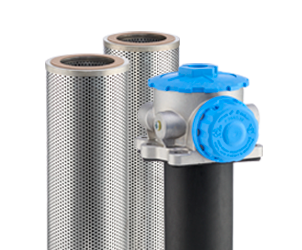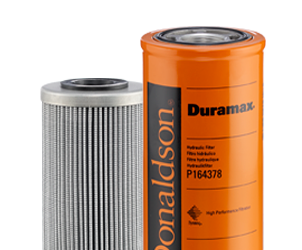Filtration is a vital component of hydraulic systems that generate usable power for agricultural, construction and other heavy-duty equipment.
Though it’s rare to find machinery that uses every type of hydraulic filter, most systems do use multiple points of filtration. Each filter is designed to remove contaminants to help protect and extend the life of the expensive equipment – and each machinery manufacturer balances cost and physical constraints against the most efficient way to protect the system and chooses its filters accordingly. When it's time to replace hydraulic filters, it's important to understand the differences in specifications and the importance of quality filtration.
What are the types of hydraulic filters?
The following are the most common filters used in hydraulic system circuits. Each filter’s location in the system and the pressure at that location are important considerations when choosing a replacement filter.

Low-pressure filters
These are found in most hydraulic systems, generally between the tank and the pump, in-line on the return journey to the hydraulic tank. Low-pressure hydraulic filters are typically rated for pressures of up to 24 bar/350 psi. The primary purpose of this filter is to keep large contaminants from getting to the pump.

Medium-pressure filters
Medium-pressure filters are usually designed as in-line components, either as a spin-on or as a cartridge-bowl solution. They are usually rated for use at pressure levels of 20–138 bar/90–2,000 psi. Typically, these filters are used to collect the debris generated during equipment operation.

High-pressure filters
High-pressure, cartridge-style filters are typically located between the pump and components like motors, cylinders and valves, and are designed to offer maximum protection. They help protect these critical components from catastrophic (and expensive) failure. High pressure filters are typically rated for pressure levels between 130 bar/1,885 psi and 450 bar/6,500 psi (or higher).

In-tank filters
In-tank filters are low-pressure filters for the reservoir or tank, a space-saving design which positions the head on the top of the tank and the cartridge inside for return and suction line filtration. Typically, these filters are used to collect the debris generated during equipment operation and help keep the reservoir clean

Strainers
A strainer is a device made of wire mesh typically located within the reservoir. Its job is to remove large particles from a fluid as hydraulic fluid approaches the suction side of a pump.

Breathers
Hydraulic fluid moves in and out reservoirs in order to power hydraulic circuits. As fluid moves, it needs to be displaced by air. Since typical job sites are full of dirt, dust and moisture, if left unchecked, these contaminants can enter reservoirs and hydraulic circuits. Breathers (such as Donaldson T.R.A.P) are designed to maintain clean airflow in and out of reservoirs and can prevent moisture and airborne particulate above 3 micron contamination from entering circuits.
The importance of pressure and efficiency ratings
Every single filter has been designed to handle a certain level of pressure, depending on its location in the hydraulic circuit. A filter positioned between the tank and the pump, for instance, is low-pressure rated, whereas a filter positioned directly after the pump will typically need a high-pressure rating. Higher efficiency filters are required for components that have a high-pressure rating.
Yet pressure isn't the only thing to take into consideration; filtration efficiency also matters. The more efficient a filter is, the fewer particles it allows downstream. High-efficiency filters allow fewer contaminants through but can restrict flow; while low-efficiency filters have a less restriction but allow more contaminants through.
It makes perfect sense to assume you should always choose a high-efficiency filter to better protect components, but that’s not always the best choice. Most pressure and return filters have a bypass function to protect the system from damage caused by cold start (high viscosity), insufficient oil flow or pressure buildup. This means that if the filter becomes clogged or over-performs because its efficiency level isn’t ideal for the application, a valve opens to protect the system — but also allows unfiltered oil and contaminants through.
It's a delicate balance between effective filtration and choking the system through over-efficiency, and it’s essential that any replacement filters are chosen according to both efficiency and pressure values recommended by the machine's manufacturer.
The bypass can be located in either the element or the head. You must also make sure that you replace a filter with one that uses the same design structure — if the worn filter has its bypass in the head, your replacement filter must also have its bypass in the head.
Tips for trouble-free filter replacement
- Follow your equipment manufacturer's recommendations for frequency of system maintenance. This is usually expressed in terms of working hours.
- Check your equipment manufacturer's manual for recommendations for each filter's pressure and efficiency value, and stick to them.
- Don't just choose the cheapest filter available. Filters from reputable manufacturers undergo stringent testing for performance and longevity. A well-made and effective filter will protect the more valuable components on your machinery for far longer and without the risk of unexpected downtime.
- If in doubt, contact your Donaldson experts for guidance.
Hydraulic Filter Servicing Video





